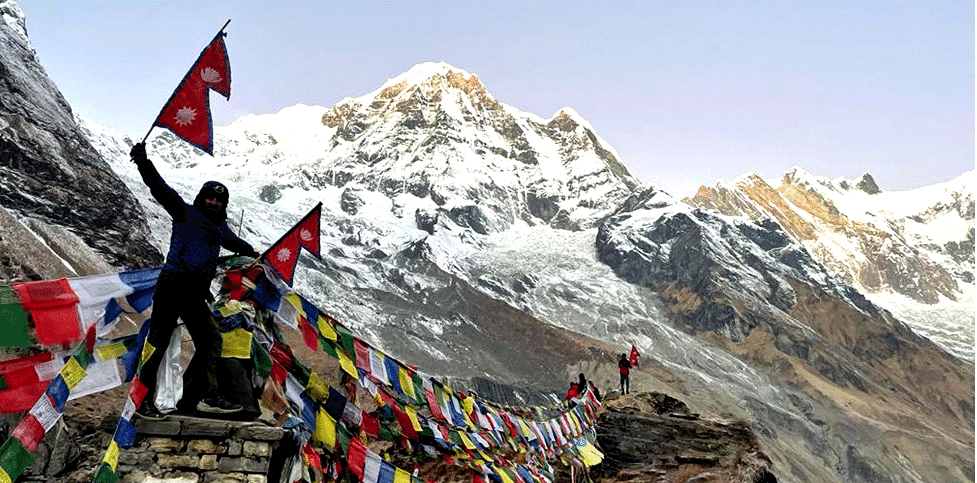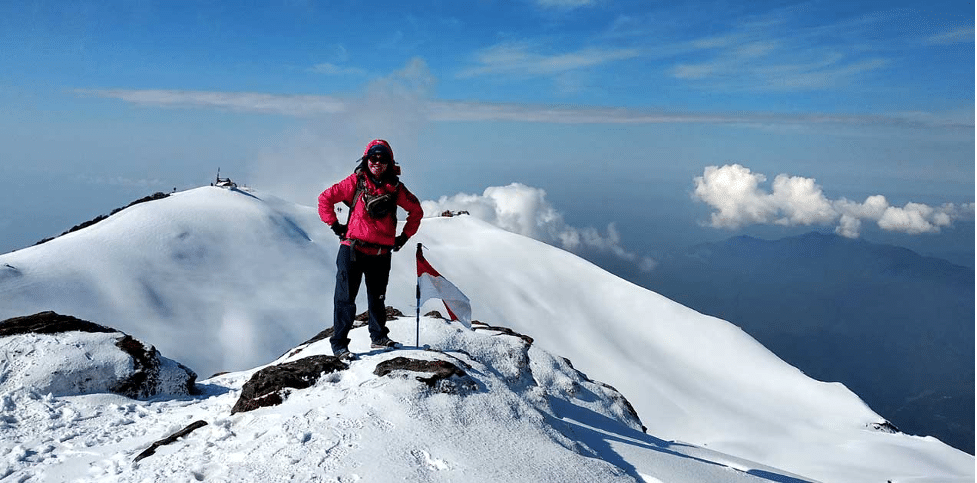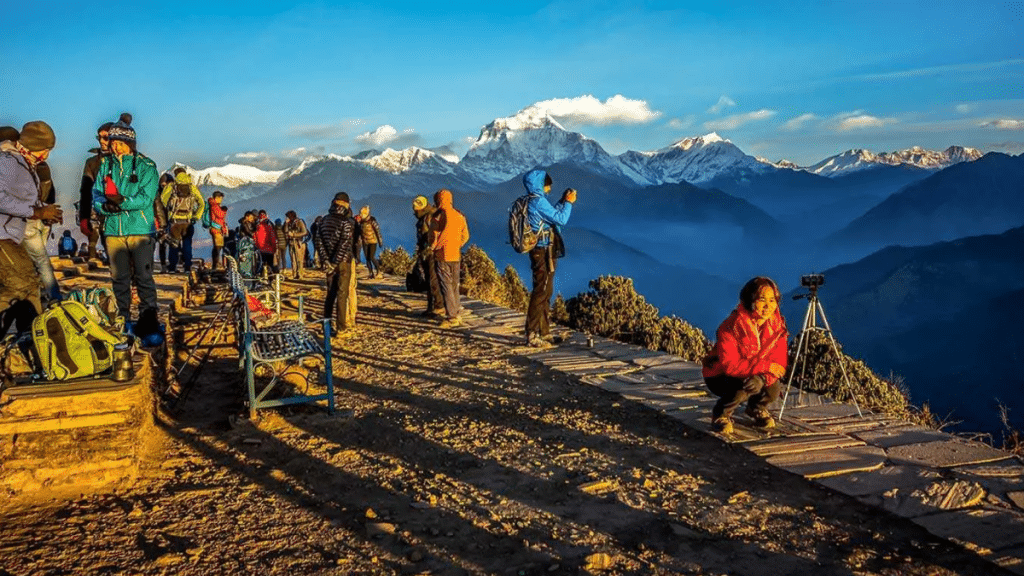Trekking in Nepal offers endless trails that weave through the magnificent Himalayas, but few districts typify differences, openness, and beautiful ponder very like the Annapurna region. Settled in the heart of central Nepal, this range is home to a few of the most famous treks: the Poon hill trek, the Annapurna Base Camp (ABC) trek, and the Mardi Himal trek. Whereas each path offers a one of a kind viewpoint of the Annapurna massif, combining them paints a total representation of nature, culture, and adventure.
This combined trekking encounter permits trekkers to wander at awe-inspiring dawn sees, rise to the foot of the world’s tenth most noteworthy top, and investigate off-the-beaten-path ridges—all in one trip. Whether you are a first-time guest to Nepal or a prepared trekker looking for a modern challenge, this trio conveys an exceptional trip through Nepal’s most photogenic landscapes.
Poon hill trek: Portal to the Annapurnas
The Poon hill trek is regularly respected as the idealized presentation to trekking in Nepal. Found in the lower Annapurna region, this brief but fulfilling travel starts from Nayapul or Hile, steadily winding through terraced areas, rhododendron timberlands, and conventional Gurung and Magar towns. It comes to its climax at Poon hill (3,210 meters)—a well known vantage point advertising a 360-degree all encompassing dawn view of the Himalayan giants.
From the beat of Poon hill, trekkers can witness the brilliant shine of first light breaking over Dhaulagiri (8,167 m), Annapurna I (8,091 m), Machapuchare (Fishtail, 6,993 m), and other peaks. The minute is regularly portrayed as magical—an immortal Himalayan display that requires moderately small acclimatization or specialized climbing.
This trek too offers profound social experiences. Towns like Ghorepani and Tadapani give bits of knowledge into nearby conventions, with stone-built houses, supplication banners rippling in the wind, and warm-hearted neighborliness. With its brief term (as a rule 4–5 days), the Poon hill trek is perfect for those who need a taste of Nepal’s precipitous excellence without the requests of high-altitude trekking.
Annapurna Base Camp trek:

For those who wish to go more profound into the mountains, the Annapurna Base Camp trek is a common expansion of the Poon hill course. This classic trek leads explorers right into the Annapurna Asylum, a covered up amphitheater of towering peaks encompassed by vertical cliffs and glaciers.
Starting from Chhomrong—a key intersection town interfacing different trails—the trek takes after the Modi Khola waterway upstream through bamboo timberlands and elevated knolls. Continuously climbing past Dovan, Himalaya, and Machapuchare Base Camp (MBC), trekkers in the long run reach the fabulous Annapurna Base Camp (4,130 meters). From here, you are encompassed by a 360-degree divider of snow-capped mountains, counting Annapurna I, Annapurna South, Hiunchuli, and Machapuchare.
The ABC trek is more physically demanding than Poon hill but sensible for most fit trekkers. The scene transition—from subtropical woodlands to frigid moraine—makes it one of Nepal’s most outwardly assorted climbs. In addition, the otherworldly vitality of the Annapurna Asylum, considered sacrosanct by both Hindus and Buddhists, includes a more profound measurement to the experience.
Most schedules permit for a drench in the normal hot springs at Jhinu Danda on the return trek—an idealized way to ease sore muscles after coming to the base camp.
Mardi Himal trek:

While ABC and Poon hill have long pulled in swarms, the Mardi Himal trek offers a calmer, more hints Himalayan experience. Tucked absent on the eastern edges of the Annapurna run, this generally modern path has picked up ubiquity for its staggering sees, brief term, and untainted environment.
The trek starts at Kande or Dhampus, rising through rich rhododendron timberlands to reach Woodland Camp, Moo Camp, and in the long run Tall Camp at around 3,580 meters. From here, the path climbs to Mardi Himal Base Camp (4,500 meters)—an edge that conveys breathtaking close-up views of Machapuchare, Annapurna South, and Hiunchuli.
What sets Mardi Himal apart is its isolation and tough charm. The path winds along limit ridgelines or maybe than profound valleys, advertising unhindered vistas of the Annapurna extend at about each step. With less teahouses and a more farther feel, it’s perfect for trekkers looking for a mix of tranquility and scenery.
Despite its distant feel, Mardi Himal is open and can be completed in as little as 5–7 days. The path can be associated with the ABC or Poon hill courses for a comprehensive trekking circuit that maintains a strategic distance from backtracking and maximizes exploration.
Combining the Three: One Epic Annapurna trek
Each of these treks—Poon hill, ABC, and Mardi Himal—can be completed separately. But when astutely combined, they make an exceptional 2–3 week Himalayan experience that exhibits the full splendor of the Annapurna region.
Sample Combined Schedule (17–20 Days):
Day 1–3: Pokhara – Nayapul – Ghorepani – Poon hill sunrise
Day 4–6: Tadapani – Chhomrong – Bamboo
Day 7–9: Deurali – MBC – Annapurna Base Camp
Day 10–11: Return to Jhinu Danda – Hot springs
Day 12–13: Landruk – Woodland Camp (Mardi Himal path begins)
Day 14–16: Moo Camp – Tall Camp – Mardi Himal Base Camp
Day 17–18: Return to Siding or Lwang – Drive back to Pokhara
This course offers a circular trek that minimizes reiteration whilst maximizing introduction to the Annapurna’s different biological systems. Trekkers start with the social abundance and forested excellence of Ghorepani, rise to the frosty magnificence of ABC, at that point conclude with the windswept ridgelines of Mardi Himal. All inside a moderately compact topographical zone, making the coordinations reasonable and rewarding.
Cultural and Characteristic Lavishness Over the Region
One of the key qualities of the Annapurna region is the concordance between characteristic excellence and social dynamic quality. Trekkers navigate through towns occupied by Gurung, Magar, and Tamang communities—each with its claimed tongue, dress, and conventions. From supplication wheels and chortens to mountain cloisters and conventional melodies, each step is imbued with nearby life.
Flora and fauna too alter drastically. You’ll pass through bamboo woodlands, rhododendron forests, tall snow capped glades, and indeed frigid moraine. The biodiversity inside the Annapurna Preservation Zone is colossal, with sightings of langurs, musk deer, and handfuls of fowl species common along the trail.
When to Go: Best Seasons for Trekking
The best time to combine these three treks is amid the spring (March to May) and harvest time (late September to November). Spring offers blooming rhododendrons and a gentle climate, whereas harvest time gives the clearest skies and the most steady conditions.
Winter trekking (December–February) is conceivable, especially on Poon hill and Mardi Himal, but snow may get to ABC and higher areas. Rainstorm season (June–August) is by and large debilitated due to dangerous trails and cloud-covered views.
Accommodation, Nourishment & Facilities
All three treks work beneath the teahouse system—local lodges that give basic settlement and suppers. Anticipate generous dishes like dal bhat, noodles, soups, and hotcakes. Tea and coffee are promptly accessible, and menus are decently standardized over the region.
Electricity, Wi-Fi, and hot showers are accessible in most towns (regularly for a little charge), but unwavering quality diminishes with elevation. Convenience ranges from essential rooms with shared lavatories to more comfortable lodges in prevalent parks like Ghorepani, Chhomrong, and Tall Camp.
Required Permits
To trek in the Annapurna region, you will need:
Annapurna Preservation Range Allow (ACAP)
TIMS (Trekkers’ Data Administration Framework) Card
These are effortlessly realistic in Pokhara or Kathmandu through trekking organizations or the Nepal Tourism Board. Make beyond any doubt to carry additional visa photographs and duplicates of your ID.
Fitness & Trouble Level
The combined trek includes both progressive climbs and more strenuous climbs. Whereas no specialized mountaineering is required, trekkers ought to be in great physical shape and able to walk 5–7 hours every day. Legitimate acclimatization is built into the agenda, particularly for tall focuses like ABC and Mardi Himal Base Camp.
Why Combine the Treks?
Scenic assortment: From dawn perspectives to base camps and edge walks.
No reiteration: Courses can be circled imaginatively to dodge backtracking.
Cultural drenching: More towns, more intuitive, more insight.
Better esteem: One allow, one trip—three experiences.
Great for blended bunches: Cater to diverse wellness and intrigued levels inside one trek.
Conclusion
The Annapurna region is a world of contrasts and connections—snow-capped summits reflected in peaceful lakes, old towns surrounded by towering peaks, and bustling trails driving to calm corners of the wild. By combining the Poon hill trek, Annapurna Base Camp trek, and Mardi Himal trek, you set out on a more than fair trek. You travel through Nepal’s history, heart, and good countries in one consistent narrative.
For those looking for the extreme Himalayan experience without wandering to extraordinary elevations or inaccessible coordinations, this combined Annapurna involvement is essentially unmatched. So bind up your boots, charge your camera, and plan for a path that offers three points of view of the same magnificent range—each more breathtaking than the last.
FAQs
1. Can I do all three treks without a guide?
Yes, experienced trekkers can do these treks freely, but enlisting a guide guarantee guarantees security, social knowledge, and course flexibility.
2. What’s the add up to the term of the combined trek?
You’ll require 17–20 days to comfortably total all three treks with rest and acclimatization days.
3. Is height ailment a concern?
ABC and Mardi Himal reach heights over 4,000 meters. Whereas the hazard is moo with appropriate pacing, continuously remain hydrated and climb gradually.
4. Do I require uncommon equipment?
Standard trekking adapt suffices—layers for shifting temperatures, strong boots, a down coat, and a great resting pack are essential.
5. Can apprentices handle this combination?
With great wellness and arrangement, yes. The trek builds dynamically and can be balanced to suit your pace.
Contact Details
Company address: Nepal Wilderness Trekking Pvt. Ltd.
Kathmandu, Nepal
Mobile & WhatsApp: +9779849693351
Email:info@nepalindependentguide.com
Website: https://www.nepalindependentguide.com
